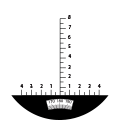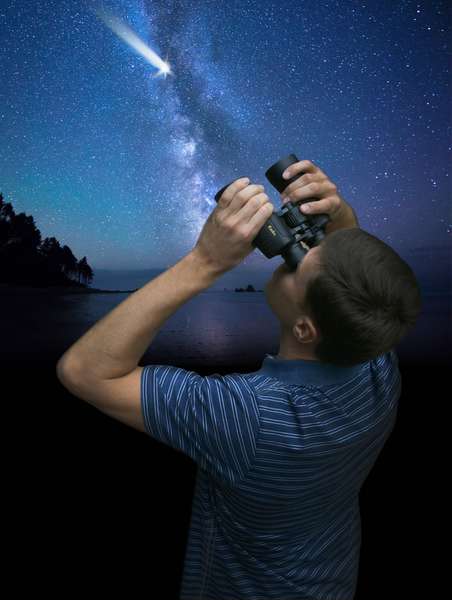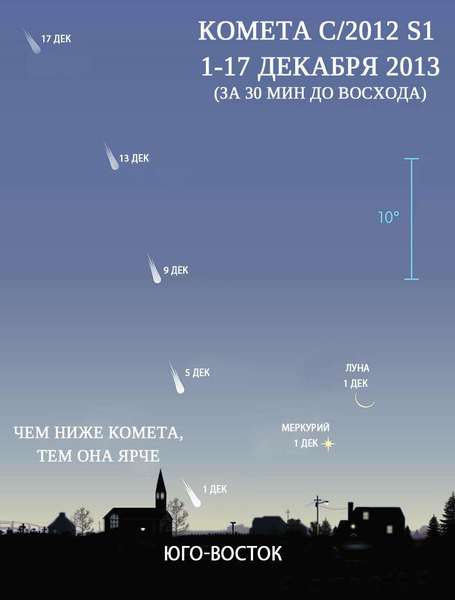Astronomical binoculars
So which tool is optimal for observations of the comet?
Oddly enough it's not a telescope, and even not a spyglass. Don't be surprised this is binocular. It is the binoculars, and the largest increase. Recommended by professionals for such observations increase from 7 to 10 times, objective lens diameter (aperture) – 40..50 mm. Possible to give very specific advice on which converge many astronomers using binoculars 7x50. This size provides the optimum balance of characteristics of an image for comfortable observation. This dimension of the binoculars is in the line of many producers and retail prices are very different!
-

Powerful field binoculars 20x50 Sturman green for ground-based observations because of the highly remote objects
- Magnification 20x diameter of lens - 50 mm
- Field of view is 3.2° (56 m/1000m)
- Porro prism glass Bk-7
Multi - layer coating of the lenses
The Central focus at a distance of 10 m
- Rubber-coated housing made of aluminium alloy, color green
- Mounted on a tripod via adapter (optional)
- Comes with protective caps, shoulder strap and case -

Binoculars Sturman 7x50 green for hunting and nature observation, elementary astronomical observations
- Increase 7x, diameter of lens - 50 mm
- Field of view - 8° (140 m/1000m), exit pupil diameter - 23 mm
- Porro prism glass Bk-7
Multi - layer coating of the lenses
The Central focus at a distance of 4 m
- Rubber-coated housing made of aluminium alloy and impact resistant plastic, color – green
- Tripod mounting via adapter (sold separately)
- Comes with a protective cap, case and strap -

Binoculars Sturman 7x50 camouflage for hunting and nature observation, elementary astronomical observations
- Increase 7x, diameter of lens - 50 mm
- Field of view - 8° (140 m/1000m), exit pupil diameter - 23 mm
- Porro prism glass Bk-7
Multi - layer coating of the lenses
The Central focus at a distance of 4 m
- Rubber-coated housing made of aluminium alloy and impact resistant plastic, color camouflage
- Tripod mounting via adapter (sold separately)
- Comes with a protective cap, case and strap -

Field glasses Sturman 20x60 green for terrestrial or astronomical observations because of the highly remote objects
- Magnification 20x, lens diameter 60 mm
- The field of view of 3.4° (59,6 m/1000m), exit pupil diameter - 9 mm
- Porro prism glass Bk-7
Multi - layer coating of the lenses
The Central focus at a distance of 5 m
- Rubber impact-resistant housing made of aluminum alloy, colour - camouflage (khaki)
- Mounted on a tripod via adapter (optional)
- Comes with protective caps, shoulder strap and case -

Binoculars Sturman 7x50 WP WA for hunting, fishing and boating
- Increase 7x, diameter of lens - 50 mm
- The field of view of 7.2° (128 m/1000m), exit pupil diameter - 17 mm
- Porro prism glass BaK-4
Multi - layer coating of the lenses
The Central focus at a distance of 8 m
- Waterproof rubber housing-aluminum alloys, turn-and-slide eyecups
- Installation on a tripod using adapter (sold separately)
- Comes with a linked covers lenses and eyepieces, case and strap -

Binoculars 10x50 Sturman ATAKER for the initial terrestrial and astronomical observations
- Magnification 10x, diameter of lens - 50 mm
- Field of view is 6.5° (114 m/1000m), exit pupil diameter - 19 mm
- Porro prism glass BaK-4
Multi - layer coating of the lenses
The Central focus at a distance of 5 m
- Waterproof rubber housing-aluminum alloys, turn-and-slide eyecups
- Installation on a tripod using adapter (sold separately)
- Comes with PU leather case, covers lenses and eyepieces, a wide shoulder strap -

Binoculars Sturman ATAKER 8-20х50 for monitoring moving objects and the initial actionability
- Magnification 8-20x diameter of lens - 50 mm
- Field of view is 4.2 and 2.6° (73-45 m/1000m), exit pupil diameter - 16.5 mm
- Porro prism glass BaK-4
Multi - layer coating of the lenses
The Central focus at a distance of 5 m
- Waterproof rubber housing-aluminum alloy
- Installation on a tripod using adapter (sold separately)
- Comes with PU leather case, covers lenses and eyepieces, a wide shoulder strap -


All-weather binoculars Sturman 7x50 with built in compass for hunting Hiking and nature observation
- Increase 7x, diameter of lens - 50 mm
- Field of view is 7.6° (132 m/1000m), exit pupil diameter - 23 mm
- Porro Prism
- Aspherical lens with a multilayer anti-reflective coating
- Separate focus at distance of 4 m, the diopter adjustment (-5 to+8 diopters)
- Built in compass with illuminated dial and angular mesh
- Rubber coated waterproof body, rubber eyecups
- Nitrogen filling
- Tripod mounting via adapter (sold separately)
- Comes with protective caps, bag and strap in the color of the body of the binoculars -

Planetary binoculars 15x70 Sturman for astronomical and terrestrial observations
- Magnification 15x diameter of the lens - 70 mm
- Field of view - 4.4 degrees (77 m/1000m), exit pupil diameter - 18 mm
- Porro prism glass BaK4
Multi - layer coating of the lenses
The Central focus at a distance of 13 m
- Rubber-coated housing made of aluminum alloy
- Mounted on a tripod via adapter (optional)
- Comes with protective caps, strap & case -

Powerful field binoculars 20x50 Sturman camouflage for ground-based observations because of the highly remote objects
- Magnification 20x diameter of lens - 50 mm
- Field of view is 3.2° (56 m/1000m)
- Porro prism glass Bk-7
Multi - layer coating of the lenses
The Central focus at a distance of 10 m
- Rubber-coated housing made of aluminium alloy, color camouflage (khaki)
- Mounted on a tripod via adapter (optional)
- Comes with protective caps, shoulder strap and case -

Binoculars 12x50 Sturman for wildlife observation and much remote objects
- Magnification - 12x, diameter of lens - 50 mm
- The field of view of 5.6° (97 m/1000m), exit pupil diameter - 11 mm
- Porro prism glass Bk-7
Multi - layer coating of the lenses
The Central focus at a distance of 5 m
- Housing - the combination of impact-resistant plastic and aluminium alloy, rubber, color green
- Mounted on a tripod (1/4") using adapter (sold separately)
- Comes with protective caps, strap and case -

Field glasses Sturman 20x60 camouflage for terrestrial or astronomical observations because of the highly remote objects
- Magnification 20x, lens diameter 60 mm
- The field of view of 3.4° (59,6 m/1000m), exit pupil diameter - 9 mm
- Porro prism glass Bk-7
Multi - layer coating of the lenses
The Central focus at a distance of 5 m
- Rubber impact-resistant housing made of aluminum alloy, color camouflage (khaki)
- Mounted on a tripod via adapter (optional)
- Comes with protective caps, shoulder strap and case -

Binoculars 12x50 Sturman camouflage for wildlife observation and much remote objects
- Magnification - 12x, diameter of lens - 50 mm
- The field of view of 5.6° (97 m/1000m), exit pupil diameter - 11 mm
- Porro prism glass Bk-7
Multi - layer coating of the lenses
The Central focus at a distance of 5 m
- Housing - the combination of impact-resistant plastic and aluminium alloy, rubber, color "camouflage"
- Mounted on a tripod (1/4") using adapter (sold separately)
- Comes with protective caps, strap and case

 Comet C/2012 S1 was opened on 21 September 2012 by Amateur astronomers Vitaly Nevsky and Artyom Novichonok by 40-cm telescope reflector mounted on the Observatory project ISON (international Scientific Optical Network) near Kislovodsk. At the time of opening it had brightness 18m (magnitude describes the brightness of the object. Than magnitude smaller — the object brighter. The weakest available to the naked eye swezy have a brightness of about 6m, the Moon full moon is -12,7 m, Sun -26,7 m), gas-dust cloud was visible angular size is 10". The actual diameter of the comet's nucleus is approximately 3-5 km.
Comet C/2012 S1 was opened on 21 September 2012 by Amateur astronomers Vitaly Nevsky and Artyom Novichonok by 40-cm telescope reflector mounted on the Observatory project ISON (international Scientific Optical Network) near Kislovodsk. At the time of opening it had brightness 18m (magnitude describes the brightness of the object. Than magnitude smaller — the object brighter. The weakest available to the naked eye swezy have a brightness of about 6m, the Moon full moon is -12,7 m, Sun -26,7 m), gas-dust cloud was visible angular size is 10". The actual diameter of the comet's nucleus is approximately 3-5 km.  About 2 weeks after perihelion, the comet head will have the same Shine as before to go around the Sun, but now she is going to have a spectacular tail extending 10-20°.
About 2 weeks after perihelion, the comet head will have the same Shine as before to go around the Sun, but now she is going to have a spectacular tail extending 10-20°. 





